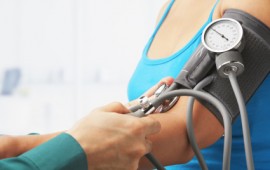Do You Know if You Have High Blood Pressure?
Author: Shannon Miller Lifestyle

Have you been told that you have high blood pressure?
Uncontrolled High Blood Pressure (HBP) can cause health problems which may injure you with damage to the heart and arteries, stroke, kidney damage, loss of vision, and more. HBP is often called the “silent killer” because there are often no symptoms, so people are not aware of the damage high blood pressure is doing.
Blood Pressure is read by two numbers:
- the Systolic, which sits on top
- the Diastolic, which sits on the bottom
The Systolic is the measurement of the pressure in the arteries when the heart contracts. Imagine the heart squeezing inward. That pressure on the vessels is systolic. The Diastolic number is the pressure on the arteries when the heart expands back outward and takes a moment to rest. The systolic number is usually higher than the diastolic.
Because there are two numbers, there are two possible causes for concern when the doctor calls something “high blood pressure.” Sometimes the problem is in the action of the heart, and sometimes it is in the rest phase. Most often, if there is a blood pressure problem, it is in both numbers.
To see how you stack up, see the following chart by The Mayo Clinic:
| Top number (systolic) in mm Hg | Bottom number (diastolic) in mm Hg | Your category* | What to do** | |
| Below 120 | and | Below 80 | Normal blood pressure | Maintain or adopt a healthy lifestyle. |
| 120-139 | or | 80-89 | Prehypertension | Maintain or adopt a healthy lifestyle. |
| 140-159 | or | 90-99 | Stage 1 hypertension | Maintain or adopt a healthy lifestyle. If blood pressure goal isn’t reached in about six months, talk to your doctor about taking one or more medications. |
| 160 or more | or | 100 or more | Stage 2 hypertension | Maintain or adopt a healthy lifestyle. Talk to your doctor about taking more than one medication. |
If your doctor confirms you have High Blood Pressure:
If your doctor simply says “You have high blood pressure,” be sure to ask for details.
- How high? What are the numbers?
- What treatment program do you recommend?
Your doctor will also ask about family history. If you don’t know, it’s time to ask around. It’s possible that your high blood pressure runs in the family. If it does, you have the opportunity to break the cycle. However, sometimes you can only bring your blood pressure down some with a healthy lifestyle. You sometimes have to add medicine to keep it in a safe range.
The number one way to bring blood pressure down is through exercise. Challenging the heart with regular cardiovascular exercise can significantly reduce blood pressure. Just check with your doctor for parameters for your exercise.
The number two way to reduce blood pressure is through eating the DASH (Dietary Approach to Stop Hypertension) diet. DASH is recommended by the American Heart Association.
In a nutshell, the DASH diet includes:
- Consuming 1500 mg of sodium per day, or less
- 6-8 servings of whole grains per day
- 4-5 servings of vegetables (fresh or frozen, not canned) per day
- 4-5 servings of fruit per day
- 2-3 servings of dairy (low fat) per day
- 6 or fewer servings of lean protein per day. Fish is recommended.
- 4-5 servings of nuts or legumes a week
- 2-3 servings of unsaturated fats per day. Omega-3s are recommended.
- 5 or fewer servings of sweets per week
- 2 or fewer alcoholic drinks per day
